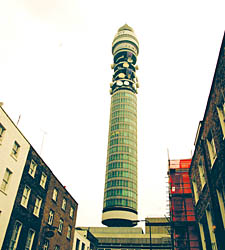|
|
 |
| |

The BT Tower, formerly the Post Office Tower |
The fascinating tall story of a landmark high-tech structure
In the first of an occasional series on the stories behind iconic buildings, Dan Carrier explores the history of the BT Tower
IT is a point of reference across the capital. You can see it from almost anywhere in London.
And when you reach the top of the Telecom Tower, the 1960s building that dominates Fitzrovia, you can’t help but feel like Gulliver surveying Lilliput.
When Labour leader Harold Wilson told delegates at the 1963 party conference they were living in an era forged by “the white heat of technology”, he could have been talking about the General Post Office’s soon-to-be-finished communications hub in the West End. The project to build the Post Office Tower – as it was then known – began in 1961 and was completed four years later. It was a superb architectural and engineering feat, and, 40 years later, stands as a monument to a time when Britain was on the cusp of the computer age.
For my generation, it has always dominated the skyline. From Parliament Hill, the tower is a reliable guide to point out less obvious buildings. I recall the night in 1984 its name changed from the Post Office Tower to the BT Tower. Margaret Thatcher was selling off the family silver in the dash for privatisation, and, to celebrate, they dressed the tower up in lights.
It became a beacon of Thatcherism, while previously it had been a testimony to state-run industry.
Access to the tower is now restricted: the IRA bomb attack in 1971 was the culmination of 100 hoax threats in the five years it had been open. It was classed an official secret until recently – making it an offence to take pictures of the building. It was left off Ordnance Survey maps until the mid-1990s.
It’s a shame – public funds built it, but the public can’t go inside.
Now the revolving restaurant on the 34th floor is used sparingly for corporate events and to host the BBC’s charity show Children In Need.
A manned lift whisks you upwards, and the speed of ascent is incredible – it makes your ears pop – and then, as you step out, your breath is caught by the incredible view. Floor-to-ceiling windows give a 360-degree sightline. The South Downs are visible beyond Crystal Palace. The Christchurch in Hampstead, the spire of Highgate’s St Michaels, the green dome of St Josephs and Dartmouth Park Hill all feel close enough to touch.
The day I visited, engineers were doing a spot check on the mechanism that turns the restaurant. It sounds like it should be complicated – a rotating floor on the top of a 620ft tall block – but it is deceptively simple. A railway track runs round the edge of the building, and the entire floor is sitting on wheels. At the flick of a switch, a small electric motor starts up and the restaurant begins to move clockwise.
The tower was originally mooted before the war. The General Post Office began buying the site in 1936, but the tangled legal process of purchasing land from 40 different freeholders meant this was not completed by 1939. By then the government’s mind was elsewhere.
The Ministry of Public Building and Works designed and built it, and considered making it square. However, wind-tunnel tests and the need to point aerials in different directions meant its circular design was chosen.
The tower weighs in at 13,000 tonnes, and, as surveyors considered how deep the foundations should be, they came across a problem. A layer of chalk to sink the base on was 53 metres underground. The clay immediately below the surface would not be stable so engineers looked at how to make sure the tower was safe without digging down too far. They built a subterranean concrete raft laced with steel cables for the tower to sit on. For further stability, a hollow concrete shaft sitting on the platform runs from top to bottom.
Heat and cold cause the structure to expand and contract – it can be 23 centimetres shorter in the winter than it is in the summer. It is also designed to sway in the wind and can lean 20 centimetres in any direction.
When Prime Minister Harold Wilson opened the tower on October 8 1965 it was Britain’s highest building, and was visited by one million visitors in its first year of opening. To build such a tower in the heart of London in just four years was a remarkable achievement. The Post Office spent £2.5m on its construction, and, even with inflation, it seems a small sum.
The Grade-II listed building still has a telecommunications role to play. It handles calls for BT and 99 per cent of all live football and terrestrial television passes through its domes and dishes. |
 |
|
 |
|
 |
|

